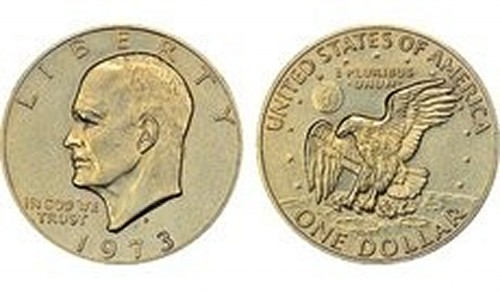1973-S Dollar Struck on Circulation Planchet
|
By Paul Gilkes-Coin World Staff | July 20, 2011 10:00 a.m.
California collector Lee Lydston obtained at face value at a local bank this wrong planchet error 1973-S Eisenhower dollar struck on a copper-nickel clad planchet instead of the intended silver-copper clad planchet. Images by Todd Pollack of BlueCC Photo, |
 |
An Eisenhower dollar recently obtained at face value from a California bank has been authenticated as a 1973-S dollar struck on a copper-nickel clad planchet instead of the intended silver-copper clad planchet.
Collector Lee Lydston submitted the coin to Numismatic Guaranty Corp., which certified the coin as a wrong planchet error and graded it About Uncirculated 58.
Lydston’s coin is only the second such wrong planchet error involving a 1973-S Eisenhower dollar that NGC has certified.
The discovery piece, which NGC graded Mint State 67, was obtained in September 2008 by John Wrublewski from Pioneer Numismatics in Acton, Mass. Wrublewski’s Uncirculated coin was housed in its original “Blue Ike” packaging from the U.S. Mint, and was contained in a coin lot he purchased for $150 at auction. Wrublewski’s coin, which he figured cost him $6, has been subsequently valued in the five figures.
Both Lydston’s and Wrublewski’s coins were struck on copper-nickel clad planchets (outer layers of 75 percent copper, 25 percent nickel, bonded to a core of pure copper), of the kind used for circulation strikes. The coin should have been struck on a silver-copper planchet (80 percent silver, 20 percent copper, bonded to a core of 21.5 percent silver 78.5 percent copper), the sole composition used for collector Uncirculated and Proof versions in 1973.
The weights of both error coins are near the standard 22.68-gram weight of the copper-nickel clad coins instead of the 24.59-gram weight for the silver planchets.
The edges of both Lydston’s and Wrublewski’s coins exhibit the exposed copper core, instead of the silver edge of the silver coins.
Bank find
Lydston said he was returning a $1,000 face value bag of Kennedy half dollars to the bank when he asked a teller if she had any unusual coins for him to examined. Lydston said the teller handed him three Eisenhower dollars – one was a 1971-D dollar, one a 1972 coin and the third a 1973-S coin.
Lydston said he looked at the first two coins looking for the rare Type 2 reverses on both coins, but both were Type 1s. “I wasn’t that impressed with finding a 1973 in circulation even though these were ‘mint set only’ coins and I’ve gotten them really cheaply in a raw state from local coin dealers but this one, looked fairly clean for a circulated coin,” Lydston said. “Almost with a satiny finish. I figured, what the heck, and plunked down my buck for the coin.”
Lydston said copper-nickel clad dollars typically have “a fair amount of Mint luster or shine, if you will, even when circulated. This coin was not particularly lustrous and had more of a clean, satiny finish, which is what caught my eye.”
He said “making the decision to ‘drag yet another Ike home’ was based more upon the appearance of the coin coupled with its date than simply the date of the coin.”
Since Lydston did not have a source of magnification at the bank, he had not checked the coin for a Mint mark. Lydston said when he returned home from the bank, he examined the coin under magnification and found the S Mint mark, and further checked the edge to see the exposed copper core.
“Being sensitive to the prolific counterfeiters out of China, I then took it to the scope for a close up look at the finish,” said Lydston, who specializes in Eisenhower dollars. “The coin definitely had the crisp quality of a U.S. Mint product and certain die markers from 40 percent silver 1973-S Ike’s were quite evident on the reverse eagle’s breast.
“The surfaces showed wear from circulation contact, but the protected area’s near the devices were satiny smooth.” ?
|
|
|
http://www.coinworld.com/articles/1973-s-dollar-struck-on-circulation-planchet/
Copyright
|